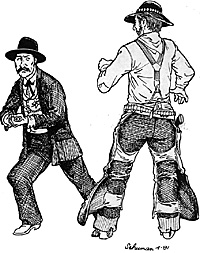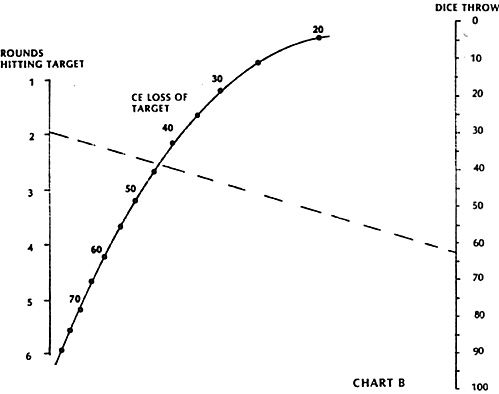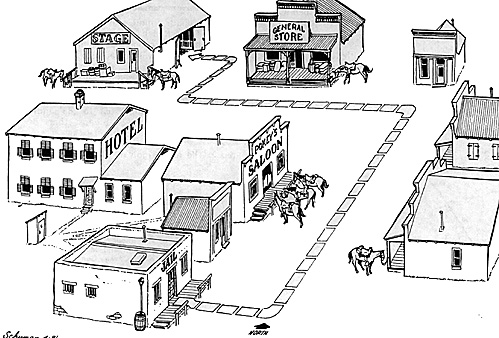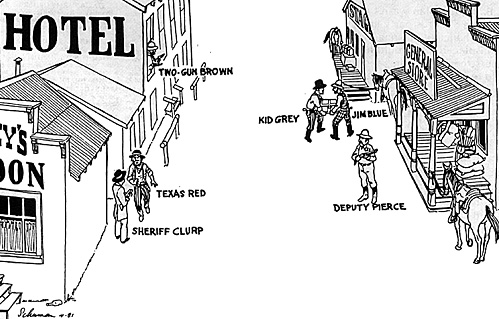INTRODUCTION
 There have been several suggestions for skirmish actions using 1/32 (54mm) figures. The relatively few figures involved ... no more than 10 to 12 per side ... lent itself well to the concept of sequencing movement by assigning a certain number of cards per man, shuffling the cards into a deck, and moving each man as his card was drawn.
There have been several suggestions for skirmish actions using 1/32 (54mm) figures. The relatively few figures involved ... no more than 10 to 12 per side ... lent itself well to the concept of sequencing movement by assigning a certain number of cards per man, shuffling the cards into a deck, and moving each man as his card was drawn.
The suggested number of cards for each type of individual was: Veteran ... 6; Experienced ... 5; Average . . . 41- Novice ... 3.
Each side's cards were combined into a deck, and card draws were alternated between decks so as to allow each side to have equal response time. The restricted number of figures ensured that the total number of cards in each deck numbered no more than 30 to 40. An increased number of figures results in a large and unwieldy deck, prolonging the movement sequence.
The other unique rules factor pertained to the figures themselves. Each man in the skirmish was represented by 4 figures: one in a standing pose, one kneeling, one prone, and one mounted. Utilization of the poses presented an effective, visual dioramic display of the situation developing on the table top . . . one can immediately see the heroes charging forward, those contemplatively ducking behind cover, and the prone cravens trying to dig a hole and pull it in after them.
The 54mm Airfix pack for Cowboys contains riflemen, six-gun shooters, and horses. Two packs supply enough figures for a six man skirmish. Some modification is necessary; there are, for instance, no prone rifleman figures. But an Xacto knife, a minimum amount of surgical expertise, a hot soldering gun, and a lot of paint to cover the resulting rough spots will suffice for the necessary conversions. Arms, legs, heads and torsos can be rapidly switched, the joints smooth over with the soldering gun, and the figure painted to hide the resultant scar tissue.
MOVEMENT SEQUENCE
The scenario described was a small one; it pitted 4 stalwart cowtown citizens against 2 bushwacking desparados:
| Name | Weapon | No. of Cards |
|---|---|---|
| Good Guys | ||
| Jim Pierce | one rifle | 4 |
| Kid Grey | one sixgun | 3 |
| Jim Blue | one sixgun | 5 |
| Sheriff Clurp | one shotgun | 6 |
| Bad Guys | ||
| Texas Red | one sixgun | 5 |
| Two-Gun Brown | two sixguns | 6 |
It should be noted that Sheriff Wyatt Clurp and Two-Gun Brown were of veteran status ... their 6 cards gave them a definite edge in reaction time over the other men.
The Good Guys' deck had 18 basic movement cards in it; the Bad Guys' deck had 11 cards. In addition to movement cards for the men involved, however, the decks also contained "horse" cards ... whenever a horse card was drawn from either deck, all mounted men would move forward 3 inches unless the rider had previously -on his own card draw - brought his horse to a stop.
A total of 19 horse cards were used and the final deck allocations were as follows- the good guys getting 6, the bad guys getting 13. Thus both decks had 24 cards. This insures that in the alternate draw sequence, both decks run out at the same time.
THE SCENARIO
High noon in Wetgulch, Texas. Sheriff Clurp and Deputy Pierce were escorting Kid Grey and Jim Blue along the main street of the town. Grey and Blue were carrying a large, heavy box laden with shining gold pieces; the box had been kept in Clurp's office/jail all night and was now being transferred to the stagecoach station office to await transportation.
Last night, the Bad Guys had come to town. Texas Red and Two-Gun Brown. They had been spotted in Pokey's Saloon next to the jail, but the Sheriff had since lost sight of them ... Clurp had no idea of where they were as he left the jail with his deputy and the gold.
Two-Gun Brown and Texas Red were permitted to hide themselves anywhere in Wetgulch they desired . . . except, of course, in the jail. As indicated in Figure 1, there were several horses hitched in town; if they could grab the gold, grab 2 horses, and ride out of town, their day would be complete.
An alternative initial positioning was also provided for Two-Gun and Tex. They could appear on the street, weapons holstered. As long as their sixguns were not drawn, Wyatt Clurp, being a man of honour, would not fire. Neither would his deputy, Pierce. Two-Gun and Tex could thus sidle up to the sheriff and hope for a lucky card draw to drop Clurp before he could fire on them.
One card was required to draw a weapon, hence TwoGun and Tex would need 2 cards each to get the drop on the Good Guys: the first to draw, the second to fire. Clurp and Pierce already had their weapons out ... one card was all they needed to fire. Kid Grey and Jim Blue were in a slightly worse predicament than the Bad Guys; their weapons were also holstered and they needed 3 cards to fire: one to drop the gold box, one to draw, and one to fire. One thing that Two-Gun and Tex were sure of: they definitely had to stay clear of Sheriff Clurp's double barrelled shotgun.
THE RULES
Each sixgun held 6 shots, of course. A man was permitted to fire whatever number of rounds he desired; he could empty his weapon at the enemy if he wished. Rifles held 10 rounds, and here, too, the weapon could be emptied on one card.
The probability of a hit was computed from the following:
Shotgun: P = 90 6 inches or less:
over 6 inches: P = (59 - (Range in inches) + Modifiers)
Sixgun: P = (39 - (Range in inches) + Modifiers)
(All ranges)
Rifles: P = (68 - (Range in inches) + Modifiers)
(All ranges)
The hit procedure was a 3 step affair. First, percentage dice were thrown to determine whether or not a hit occured in accordance with the probabilities given above. Second, if a hit was scored, the dice were thrown again to determine how many rounds of those fired actually hit the target as shown on Chart A. A third throw then was used to ascertain the number of Combat Efficiency (CE) points lost by the target.
Each man commenced the action with 100 CE points. Cross indexing the number of rounds hitting the target with the third dice throw on the nomograph of chart B produced the loss of target CE. As an example, not that the line drawn on Chart B indicates that if 2 rounds hit and the third dice throw was 63, the target would incur a 44 CE loss. Clurp's shotgun effect was accentuated by rulng that, if hit, a target would suffer twice the loss shown on the chart.

Just as in the Modern Skirmish Rules, each man's CE was used to determine his reaction to a wound. If, for example, Texas Red was blasted by the Sheriff and suffered a 22 CE loss and was therefore down to 78 CE, then Tex's response would be determined by a dice throw as follows:
| Region of Response | Dice Throw | Reaction |
|---|---|---|
| Zero to 112 CE | 0 Dice Throw 39 | Texas Red takes it like a man and merely blinks. |
| 1/2 to full CE | 40 Dice Throw 78 | Tex falls prone on stomach facing away, may perform normally on next card draw. |
| Above CE level | Dice Throw 78 | Tex falls prone on back facing away, must use one card to recover and may only turn over (may not rise) on next card draw |
Use of the charts is more fully illustrated by an example. Assume Texas Red has fired 3 rounds at his lifelong enemy, Sheriff Clurp, and that the first dice throw has indicated that Clurp was indeed hit.
Step 1. Chart A is now used to indicate how many of the 3 rounds actually hit Clurp. The dice are thrown . ...72.
Looking across the row of "3 Rounds Fired" we see that Row 72 lies in the range 66 to 85 indicated in column 2. Column '2' means that of the 3 shots, only 2 actually hit Clurp.
Step 2. The nomograph of Chart B uses another dice throw . . say, a 63. A line drawn between the 2 rounds hitting Clurp (determined from Step 1) and the dice throw of 63 intersects the CE loss line at 44 CE. Hence Clurp loses 44 CE, has 56 CE remaining of his original 100, and will have to check his reaction to the wound.
There was no attempt to account for a morale factor in the skirmish rules. The CE reaction test, for the most part accounted for both the mental and physical response of a man when he was hit. If he fell to the ground and was, in effect, incapacitated for one or two card draws, that was considered sufficient to penalize him for not being heroic enough to withstand the shock of an injury.
THE GUNFIGHT
The Sheriff and his crew commenced their walk from the jail, with Kid Grey and Jim Blue dutifully lugging the heavy box of gold.
Sheriff Clurp had 6 cards in the deck, and, within the bound, due to the frequency of his card draws, he easily outdistanced the others. No sooner had he rounded the corner of Pokey's Saloon than he ran into Texas Red, leaning nonchalantly against the wall.
"Mor'nin', Sheriff", grinned Red, in avid anticipation of what he thought would be a happy day in his career.
The Bad Guys had chosen to station Texas Red near the north wall of Pokey's place. Two-Gun Brown, a sixshooter clutched in each hand, was hidden on the second story of the Hotel. Two-Gun's view commanded the area immediately adjacent to the entrance to the Stage Office. Figure 2 shows the position of each man.
It was the Bad Guys' intent to have the sheriff and his men walk past Texas Red, after which Texas would amble along, several paces to the rear of the party, until all was well within Two-gun's field of vision. Two-Gun would then drop the Sheriff, eliminating that hellacious shotgun, while Texas would concentrate on the Deputy, Pierce.
Alas, 'twas not to be. Sheriff Clurp was no dope, and his immediate reaction, on running into Texas Red, was to walk right up to Texas and nudge him back with the muzzle of his shotgun. Even though Clurp's high standards did not permit him to fire on Texas whose guns were holstered, those same standards did permit him to administer a painful poke in the ribs to the Bad Guy.
"Now, She'ff, you got no call to push me like that!"
Texas Red's complaints fell on deaf ears as Clurp continued to push him back. While this was going on, the rest of the Good Guys rounded the bend and had almost gotten past the General Store. They were now. in full view of Two-Gun Brown.
The problem, however, was that the Sheriff, Two-Gun's target, was not in Two-Gun's view,- Clurp was on the south side of the street busily shoving Texas Red before him, and thus below Two-Gun's line of sight.
The Bad Guys couldn't afford to wait any longer, lest Kid Grey and Jim Blue vanish, with the gold, within the secure confines of the Stage Office. Push had come to Shove, this was the Crunch, the Moment of Truth, and Texas Red bit the Bullet.
On his next card, Texas Red drew his gun, with Sheriff Clurp's two-barrelled shotgun still pointing at his navel.
But Texas Red didn't bite hard enough . . . the gamble didn't pay off, for the very next card draw proved to be one of Clurp's.
"Both barrels!" muttered the Sheriff, and WHOOM!
WHOOM!, both barrels it was. Texas was blasted back, mortally wounded, only 10 CE left. He was now bleeding to death, i.e., losing 2 CE on every card draw.
The action was now fast and furious. A Two-Gun Brown card. .. Whammo!, and Kid Grey fell to the ground. Two-Gun had caused a halt to the procession and the gold box was on the ground. Deputy Pierce fired back at Two-Gun and wounded him, but Two-gun shook is off. Whammo!, and this time, Jim Blue fell, another victim of Two-Gun's.
Interspersed with these actions, one of Texas Red's cards appeared,- he rolled over and, with a final surge of strength, pointed his revolver at the Sheriff, still standing over him. But such a six card man as Wyatt Clurp was not to be done in by the likes of Texas Red. Providence provided that 2 Clurp cards in a row would be drawn before another of Texas Red's. On the first, the Sheriff calmly placed a shell in one chamber of his weapon. On the second, he pointed his shotgun at Texas ... WHOOM! and Texas Red had bitten his last bullet.
Two-Gun had meanwhile wounded Deputy Pierce, bringing his total of victims to three. Jim Blue, on the ground but ever faithful, didn't try to fire back at Two-Gun; Blue commenced to slowly crawl towards ;the door of the Stage Office, dragging the gold box with him.
Two-Gun was now torn between 2 goals: he had to stop Blue from his slow crawl to the Stage Office, and he had to get rid of Deputy Pierce, whose rifle was proving very effective in keeping him pinned down.
Two-gun debated too long . . . Pierce took careful aim and fired 5 times. two-gun fell back. "0' shukky gee!", he cried, and with this vile epithet on his lips, he expired.
The Bad Guys had lost again.
FINALE
The Bad guy's plan wasn't too bad. If they could have gotten the Sheriff's party in a crossfire, they might have stood a chance of bagging the gold. Texas Red, however, was misplaced. He should have stood on the north side of the street so that he, and anyone else close to him, would remain within Two-Gun's sight. If Texas' last gamble had worked ... he needed to draw 2 cards to Sheriff Clurp's one . . . and he had gotten the drop on Clurp, things would probably have gone as planned. But, as things turned out, Texas never even got to fire his weapon.
Two-Gun, for his part, proved amazingly effective. What he fired at, he hit. The basic probability of hit, stemming from the formula of "39 - R", where R ranged from 12 to 20 inches for the gunfight, was fairly low, and Two-Gun did well indeed.
The skirmish was a rapid one, the entire affair taking less than 4 bounds, i.e., 4 complete run-throughs of the movement decks. The final outcome was achieved in slightly less than an hour and the time passed quickly. The intent of the encounter, to show how the card system and Modern Skirmich rules could be adapted to a western gunfight setting, was satisfactorily accomplished.
The system appears to be adaptable to just about any era of weaponry. One interesting version concerns the Napoleonic period in which the process of loading and firing a musket was divided into a 5 card procedure: Card 1 ... Load powder and tamp; Card 2 ... Load ball and tamp,- Card 3 ... Prime weapon; Card 4 ... Assume firing position,- Card 5 ... Fire!
The author would appreciate hearing from those who have experimented with the card system of movement and fashioned it to fit the various weapons and periods of history.


Back to Table of Contents -- Courier Vol. III #3
To Courier List of Issues
To MagWeb Master Magazine List
© Copyright 1981 by The Courier Publishing Company.
This article appears in MagWeb (Magazine Web) on the Internet World Wide Web.
Other military history articles and gaming articles are available at http://www.magweb.com